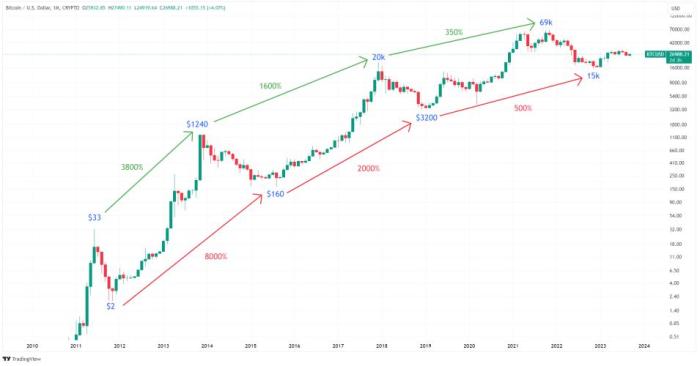Bitcoin Price Prediction 2025

Bitcoin, the pioneering cryptocurrency, has experienced a turbulent yet fascinating journey since its inception in 2009. From a niche digital asset to a globally recognized phenomenon, its price has demonstrated remarkable volatility, swinging wildly from near-zero to record highs and plummeting just as dramatically. This inherent unpredictability, however, is precisely what makes predicting its future price in 2025 a captivating challenge and a source of considerable speculation. The potential for significant gains, coupled with the risk of substantial losses, continues to attract investors and enthusiasts alike.
Bitcoin’s price is influenced by a complex interplay of factors. Technological advancements, such as the ongoing development of the Lightning Network for faster and cheaper transactions, directly impact its scalability and usability, potentially boosting its appeal and value. Conversely, regulatory decisions by governments worldwide, ranging from outright bans to comprehensive frameworks, significantly shape market confidence and accessibility. Finally, market sentiment – driven by news events, social media trends, and overall investor confidence – plays a crucial role in short-term price fluctuations. A positive news cycle can trigger a surge in buying, while negative news can spark a sell-off. Understanding these interacting forces is crucial to even attempting a reasoned forecast.
Factors Influencing Bitcoin’s Price in 2025
The price of Bitcoin in 2025 will depend on a multitude of interconnected factors, making any prediction inherently speculative. However, by analyzing historical trends and current developments, we can identify key elements that are likely to shape its future trajectory. For example, the increasing adoption of Bitcoin by institutional investors could drive significant price appreciation. Conversely, a major regulatory crackdown in key markets could negatively impact its value. The interplay of these forces, along with unforeseen events, will ultimately determine the price. Consider, for instance, the impact of El Salvador’s adoption of Bitcoin as legal tender – a bold move that, while controversial, demonstrated a government’s willingness to embrace the cryptocurrency. Similar adoptions, or conversely, restrictions, in other major economies could drastically alter the landscape. Technological innovations, such as improved privacy features or advancements in layer-2 scaling solutions, could also significantly influence price movements. Ultimately, the interplay between these factors and unpredictable market events will determine the Bitcoin price in 2025.
Analyzing Past Bitcoin Price Trends
Understanding Bitcoin’s past price movements is crucial for informed speculation about its future. Analyzing historical trends, including both periods of explosive growth and significant corrections, provides valuable insights into the factors influencing Bitcoin’s price volatility and helps contextualize any future price predictions. Examining past predictions alongside actual outcomes reveals the inherent challenges and limitations in forecasting such a volatile asset.
Bitcoin’s price history is marked by periods of intense volatility, characterized by dramatic bull and bear markets. The initial years saw slow growth, followed by periods of rapid appreciation and subsequent sharp declines. These fluctuations are driven by a complex interplay of factors, including technological advancements, regulatory developments, market sentiment, and macroeconomic conditions. Analyzing these cycles helps identify potential patterns, though it’s important to remember that past performance is not necessarily indicative of future results.
Significant Price Movements and Market Cycles
Bitcoin’s journey has been characterized by several significant price movements. The first notable bull market occurred in 2013, pushing the price from under $10 to over $1,000. This was followed by a substantial correction, a classic bear market, that saw the price fall significantly. The next major bull run began in late 2016 and peaked in late 2017, reaching almost $20,000. This was followed by another extended bear market lasting through much of 2018 and 2019. A subsequent bull market propelled Bitcoin to a new all-time high in late 2021, exceeding $60,000, before another significant correction ensued. These cycles illustrate the inherent volatility of the cryptocurrency market.
Comparison of Past Predictions and Actual Outcomes
Numerous predictions about Bitcoin’s price have been made throughout its history, ranging from extremely bullish to profoundly bearish. Many early predictions vastly underestimated Bitcoin’s potential, failing to account for its widespread adoption and the growth of the broader cryptocurrency market. Conversely, some predictions of catastrophic price collapses proved inaccurate. This demonstrates the inherent difficulty in predicting the price of an asset as volatile as Bitcoin, influenced by so many unpredictable factors. The accuracy of past predictions has been generally low, highlighting the limitations of relying solely on historical data and technical analysis for forecasting. External factors, such as regulatory changes or major technological advancements, can significantly impact price, making accurate prediction challenging.
Key Historical Price Points and Associated Events
| Date | Price (USD) | Event | Impact |
|---|---|---|---|
| July 2010 | $0.003 | First recorded Bitcoin transaction | Established a baseline for future price appreciation |
| November 2013 | ~$1,100 | First major bull market peak | Significant increase in awareness and adoption |
| December 2017 | ~$19,783 | Second major bull market peak | Increased mainstream media attention and institutional investment |
| November 2021 | ~$68,789 | Third major bull market peak | Growing institutional adoption and increasing regulatory scrutiny |
Factors Influencing Bitcoin’s Price in 2025

Predicting Bitcoin’s price in 2025 requires considering a complex interplay of technological advancements, regulatory landscapes, institutional involvement, macroeconomic conditions, and public perception. These factors are not independent; they interact dynamically, influencing each other and ultimately shaping Bitcoin’s price trajectory.
Technological Developments Impact on Bitcoin’s Price
Technological advancements hold significant potential to influence Bitcoin’s price positively. Layer-2 scaling solutions, like the Lightning Network, aim to increase transaction speed and reduce fees, addressing current limitations of the Bitcoin blockchain. Successful implementation and widespread adoption of Layer-2 solutions could lead to increased usability and potentially drive demand, thus impacting the price positively. Furthermore, upgrades like Taproot improve transaction privacy and efficiency, enhancing Bitcoin’s overall functionality and potentially attracting more users and investors. The successful integration and adoption of these technologies could significantly increase Bitcoin’s transaction throughput and reduce costs, potentially making it more competitive with other payment systems and increasing its appeal to both individual users and institutions. For example, if the Lightning Network successfully scales to handle millions of transactions per second, the reduced transaction fees and increased speed could attract a surge of new users and businesses, driving up demand and, consequently, the price.
Regulatory Frameworks and Governmental Policies Influence on Bitcoin’s Price
Governmental regulations and policies will play a crucial role in shaping Bitcoin’s future. Favorable regulatory frameworks, such as clear guidelines on taxation and anti-money laundering (AML) compliance, could foster institutional investment and wider adoption, potentially leading to price appreciation. Conversely, restrictive regulations or outright bans could stifle growth and negatively impact the price. The regulatory landscape varies significantly across different countries. For example, El Salvador’s adoption of Bitcoin as legal tender demonstrated a potential for positive price impact through increased demand, while China’s ban significantly impacted the market’s sentiment and price. The overall regulatory clarity and consistency globally will be a significant factor in determining Bitcoin’s price in 2025. A more unified and positive global regulatory approach could lead to increased institutional confidence and wider adoption, whereas inconsistent or overly restrictive regulations could hinder growth.
Institutional Investment, Macroeconomic Factors, and Public Perception’s Role in Bitcoin’s Price
Institutional investment is a key driver of Bitcoin’s price. Increased participation from large financial institutions, such as hedge funds and asset managers, often translates into increased liquidity and price stability. Macroeconomic factors, such as inflation and recession, also significantly impact Bitcoin’s price. During periods of high inflation, Bitcoin’s perceived value as a hedge against inflation might increase demand, pushing the price upwards. Conversely, during economic downturns, investors might sell Bitcoin to cover losses in other assets, potentially leading to price drops. Public perception is equally crucial. Positive media coverage and increased public awareness can boost demand, while negative news or scams can negatively impact the price. For instance, the 2021 Bitcoin bull run was partially fueled by increased institutional investment and positive media coverage, while subsequent market corrections were influenced by negative news cycles and regulatory uncertainty. The overall sentiment surrounding Bitcoin, driven by both news events and broader economic trends, will continue to be a key factor influencing its price.
Different Price Prediction Models and Methodologies
Predicting Bitcoin’s price in 2025, or any future date, is inherently challenging due to the cryptocurrency’s volatility and the influence of numerous interconnected factors. Various models attempt to forecast this price, each with its own strengths, weaknesses, and underlying assumptions. Understanding these methodologies is crucial for interpreting price predictions and assessing their reliability.
Predicting the future price of Bitcoin relies on different approaches, each using distinct data and analytical techniques. These models offer varying degrees of accuracy and are subject to inherent limitations. It’s essential to understand these limitations to avoid misinterpreting the predictions.
Technical Analysis, Bitcoin Price Prediction 2025
Technical analysis focuses on historical price and volume data to identify patterns and trends. It uses charts and indicators to predict future price movements, assuming that past price action is indicative of future behavior. Common tools include moving averages, relative strength index (RSI), and support/resistance levels. While effective in identifying short-term trends, technical analysis struggles with predicting long-term price movements due to the influence of external factors not reflected in historical price data. For example, a sudden regulatory change or a major technological breakthrough could significantly alter the price trajectory, making technical analysis less reliable for long-term predictions like those for 2025. The reliance on past data also means that unforeseen events can render these predictions inaccurate.
Fundamental Analysis
Fundamental analysis assesses the intrinsic value of Bitcoin based on factors influencing its adoption and utility. This includes evaluating factors such as the overall cryptocurrency market sentiment, regulatory landscape, technological advancements, adoption rate by businesses and individuals, and the security of the network. A higher adoption rate and positive regulatory developments, for example, are generally considered bullish factors that would potentially increase Bitcoin’s value. However, fundamental analysis is subjective and relies on interpreting complex and often unpredictable factors. Predicting these factors accurately for a timeframe as long as 2025 is extremely difficult, making it challenging to assign a precise price target. For example, accurately predicting the impact of global economic conditions on Bitcoin adoption is a significant challenge.
On-Chain Metrics
On-chain analysis examines data directly from the Bitcoin blockchain, such as transaction volume, network hash rate, and the number of active addresses. These metrics provide insights into the network’s activity and health, offering clues about potential price movements. For instance, a rising hash rate suggests increased network security and could be interpreted as a bullish signal. However, on-chain data alone doesn’t provide a direct price prediction. Correlation doesn’t equal causation; while some on-chain metrics might historically correlate with price changes, this doesn’t guarantee future price movements will follow the same patterns. Furthermore, interpreting on-chain data requires expertise and careful consideration of various confounding factors.
Comparison of Prediction Models
The following table summarizes the key characteristics of the different price prediction models:
| Model | Assumptions | Data Sources | Strengths | Weaknesses |
|---|---|---|---|---|
| Technical Analysis | Past price action repeats | Historical price and volume data | Identifies short-term trends, relatively easy to implement | Limited predictive power for long-term forecasts, susceptible to manipulation |
| Fundamental Analysis | Intrinsic value drives price | Macroeconomic factors, adoption rates, regulatory environment | Considers underlying factors influencing value | Subjective, difficult to quantify, unpredictable external factors |
| On-Chain Metrics | Blockchain data reflects network activity and sentiment | Bitcoin blockchain data (transactions, hash rate, etc.) | Provides objective data, insights into network health | Correlation doesn’t equal causation, requires expertise to interpret |
Potential Scenarios for Bitcoin’s Price in 2025
Predicting the future price of Bitcoin is inherently speculative, but by examining various influencing factors and developing plausible scenarios, we can gain a better understanding of potential price movements in 2025. The following scenarios represent three distinct possibilities, each based on different assumptions regarding technological advancements, regulatory developments, and overall market sentiment. It is crucial to remember that these are hypothetical scenarios, and the actual price could differ significantly.
Bullish Scenario
This scenario assumes widespread adoption of Bitcoin as a store of value and a medium of exchange, driven by factors such as increased institutional investment, positive regulatory developments, and growing public awareness. Technological advancements, like the scaling solutions improving transaction speeds and reducing fees, further contribute to Bitcoin’s usability and attractiveness. A successful integration of Bitcoin into mainstream financial systems could significantly increase demand, leading to substantial price appreciation. Imagine a world where major corporations hold significant Bitcoin reserves, governments are actively exploring central bank digital currencies (CBDCs) potentially interacting with Bitcoin, and everyday consumers seamlessly use Bitcoin for transactions. This level of integration would likely drive strong upward pressure on the price.
Bearish Scenario
Conversely, a bearish scenario assumes a less favorable environment for Bitcoin. Increased regulatory scrutiny, particularly in major economies, could stifle growth and lead to decreased investor confidence. A major security breach or a series of negative news events could also trigger a sell-off, causing a significant price decline. Furthermore, the emergence of competing cryptocurrencies with superior technology or a significant economic downturn could negatively impact Bitcoin’s price. Picture a scenario where several governments enact strict regulations that limit Bitcoin’s use, leading to reduced trading volume and decreased institutional investment. Coupled with a global recession impacting investor risk appetite, this could significantly depress Bitcoin’s price.
Neutral Scenario
This scenario depicts a more moderate outlook, characterized by neither significant gains nor substantial losses. In this scenario, Bitcoin experiences steady growth, but at a slower pace than in the bullish scenario. Regulatory uncertainty persists, but no major negative events occur to significantly impact investor sentiment. Technological advancements continue, but adoption remains gradual. This scenario reflects a state of market equilibrium, where Bitcoin’s price consolidates and gradually increases in value over time, mirroring a more mature asset class. This could be characterized by a period of consolidation, with price fluctuations remaining within a relatively narrow range, punctuated by periods of both upward and downward momentum, ultimately resulting in moderate long-term growth.
Risks and Uncertainties Associated with Bitcoin Price Predictions: Bitcoin Price Prediction 2025
Predicting the price of Bitcoin, or any cryptocurrency for that matter, over the long term is inherently risky. The cryptocurrency market is exceptionally volatile, influenced by a complex interplay of factors that are often unpredictable and difficult to model accurately. While various prediction models exist, they are ultimately limited by their reliance on historical data and assumptions about future events, neither of which guarantees future performance.
The inherent volatility of Bitcoin makes long-term price predictions particularly challenging. Small shifts in market sentiment, regulatory changes, or technological advancements can trigger significant price swings, rendering even the most sophisticated models inaccurate. This volatility is amplified by the relatively young age of the cryptocurrency market, limiting the availability of historical data for robust analysis. Furthermore, the decentralized nature of Bitcoin and the lack of central control make it susceptible to unforeseen events that are difficult, if not impossible, to incorporate into predictive models.
Potential “Black Swan” Events and Their Impact
Unforeseen events, often termed “black swan” events, pose a significant threat to the accuracy of Bitcoin price predictions. These are highly improbable events with a potentially devastating impact. For instance, a major security breach compromising the Bitcoin network’s integrity could trigger a significant price drop as investor confidence erodes. Similarly, unexpected and stringent regulatory crackdowns from major governments, aimed at curbing cryptocurrency trading or mining activities, could severely limit Bitcoin’s growth potential and lead to a sharp decline in its value. The 2021 China crackdown on cryptocurrency mining serves as a stark reminder of this risk. The sudden ban significantly impacted the global Bitcoin hashrate and caused price volatility.
Limitations of Prediction Models and Risk Management
Bitcoin price prediction models, whether based on technical analysis, fundamental analysis, or machine learning algorithms, rely on historical data and assumptions about the future. These models are inherently limited by the unpredictable nature of the market and the potential for unforeseen events to significantly alter the predicted trajectory. Technical analysis, for example, relies on past price patterns to predict future movements, but these patterns are not always reliable in a volatile market. Fundamental analysis assesses the underlying value of Bitcoin based on factors such as adoption rate and technological advancements, but these factors can change rapidly and unexpectedly. Machine learning models, while sophisticated, are still trained on past data and may not accurately account for novel events or shifts in market dynamics. Therefore, investors should always exercise caution and understand the limitations of these models. Diversification of investment portfolios and careful risk management strategies are crucial for mitigating potential losses associated with Bitcoin investment. The unpredictability of the market necessitates a cautious approach, recognizing that even the most well-informed predictions can be significantly inaccurate.
Investing in Bitcoin

Investing in Bitcoin in 2025 requires a careful consideration of various factors, including your risk tolerance, investment goals, and understanding of the cryptocurrency market’s inherent volatility. While Bitcoin’s potential for growth is significant, it’s crucial to approach investment with a well-defined strategy and a realistic assessment of potential risks. Remember that past performance is not indicative of future results.
Bitcoin’s price is notoriously volatile, experiencing substantial swings in both directions. Therefore, a robust investment strategy needs to account for this volatility and protect your capital. This involves not only understanding different investment approaches but also diversifying your portfolio to mitigate potential losses.
Investment Strategies
Choosing the right investment strategy is paramount for success in the Bitcoin market. Each approach carries different levels of risk and potential reward. Long-term holding, short-term trading, and dollar-cost averaging are three common strategies, each with its own set of advantages and disadvantages. Long-term holding involves buying and holding Bitcoin for an extended period, aiming to profit from its potential long-term appreciation. Short-term trading, on the other hand, involves frequent buying and selling to capitalize on short-term price fluctuations. This strategy requires significant market knowledge and timing skills. Dollar-cost averaging involves investing a fixed amount of money at regular intervals, regardless of price fluctuations. This strategy mitigates the risk of investing a large sum at a market peak.
Key Considerations for Bitcoin Investment
Before investing in Bitcoin, several crucial factors should be carefully evaluated. Failing to do so could lead to significant financial losses. A thorough understanding of these points is essential for informed decision-making.
- Risk Tolerance: Bitcoin is a high-risk investment. Assess your personal risk tolerance and only invest what you can afford to lose.
- Investment Goals: Define your investment objectives. Are you aiming for short-term gains or long-term growth?
- Market Research: Thoroughly research Bitcoin and the cryptocurrency market before investing. Understand the technology, its potential, and the associated risks.
- Diversification: Don’t put all your eggs in one basket. Diversify your portfolio to reduce overall risk. Consider investing in other asset classes alongside Bitcoin.
- Security: Securely store your Bitcoin using reputable wallets and exchanges. Be aware of the risks of scams and hacking.
- Regulation: Stay informed about the regulatory landscape surrounding Bitcoin in your jurisdiction. Regulations can significantly impact the market.
- Tax Implications: Understand the tax implications of Bitcoin investments in your country. Capital gains taxes can be substantial.
Bitcoin Price Prediction 2025 – Predicting the Bitcoin price in 2025 is a complex undertaking, influenced by numerous factors. A key event impacting this prediction is the Bitcoin Halving, which significantly alters the rate of new Bitcoin entering circulation. To understand the potential impact on the price, it’s crucial to know the precise date of this halving; you can find that information by checking the Bitcoin Halving Date In 2025.
Therefore, the halving date is a critical piece of the puzzle when formulating a Bitcoin price prediction for 2025.
Predicting the Bitcoin price in 2025 is challenging, with various factors influencing its trajectory. A significant event impacting this prediction is the upcoming reduction in Bitcoin’s block reward, commonly known as the halving, which is expected to occur in April 2025. This halving historically has led to increased scarcity and often precedes periods of price appreciation, making it a crucial element in any 2025 Bitcoin price forecast.
Therefore, understanding the halving’s potential effects is key to forming a reasonable prediction.
Predicting the Bitcoin price in 2025 is a complex endeavor, influenced by various factors including market sentiment and technological advancements. A key event impacting these predictions is the Bitcoin halving, which significantly alters the rate of new Bitcoin creation. To understand the potential implications of this event on the price, it’s crucial to know the precise Date Bitcoin Halving 2025 , as this date will greatly influence the supply dynamics and, consequently, future price projections.
Predicting the Bitcoin price in 2025 is a complex task, influenced by numerous factors. A key event impacting this prediction is the Bitcoin halving, which significantly affects the rate of new Bitcoin entering circulation. To understand the timing of this crucial event, check out this resource: When Does Bitcoin Halving Occur In 2025. The halving’s impact on scarcity and, consequently, the potential price increase in 2025, remains a central point of discussion among market analysts.
Predicting the Bitcoin price in 2025 is challenging, influenced by various factors including macroeconomic conditions and technological advancements. A key event to consider when formulating any prediction is the Bitcoin halving, which you can learn more about by checking the date at Fecha Del Halving De Bitcoin 2025. Understanding the halving’s impact on Bitcoin’s supply dynamics is crucial for a more informed Bitcoin Price Prediction 2025.
Predicting the Bitcoin price in 2025 is challenging, with various factors influencing its trajectory. A key element to consider is the upcoming halving event, and to understand its potential impact, it’s helpful to check out this resource: Is Bitcoin Halving In 2025. The halving’s effect on Bitcoin’s scarcity and subsequent price action will significantly contribute to the overall 2025 price prediction, making it a crucial aspect of any serious analysis.
Predicting the Bitcoin price in 2025 is a complex undertaking, influenced by various factors including regulatory changes and technological advancements. Successfully navigating this volatile market often requires targeted advertising, which is why managing a well-structured Google Ads Account can be crucial for businesses involved in cryptocurrency trading or analysis. Ultimately, a strong understanding of both Bitcoin’s potential and effective digital marketing strategies will be vital for anyone aiming to profit from the 2025 Bitcoin price.
